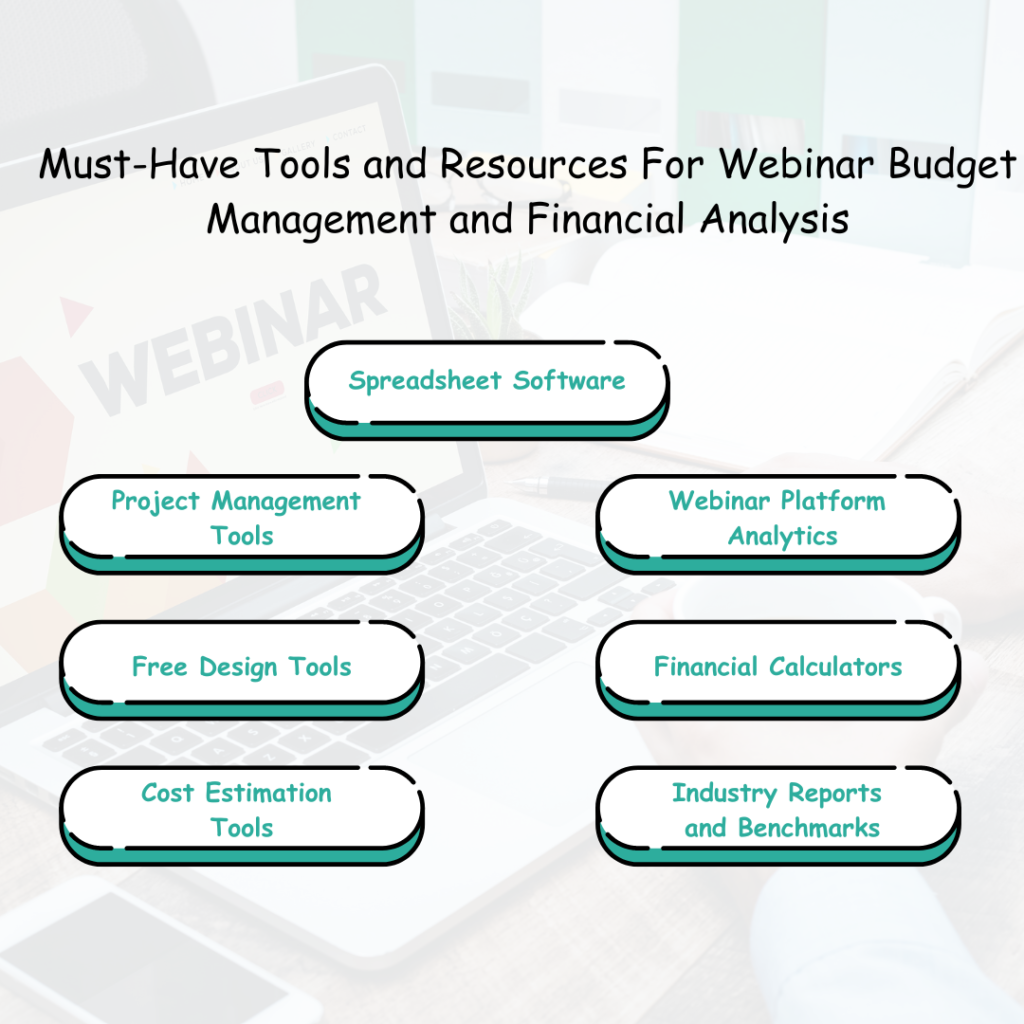So grab yourself a cup of coffee, relax, and read on as we help you with everything you need to know about webinar budget management.
Align Your Webinar Plan with Business Goals
Let’s understand how your webinars can be transformed by aligning your webinar strategy with your business goals, strengthened by efficient financial management strategies.
Business Goals and Webinar Planning
Before diving into budgets, it’s crucial to solidify your webinar plan and understand your business goals.
- Identifying Business Goals: What do you want this webinar to accomplish? What is your goal:
- Lead generation?
- Informing your audience about a recently launched good or service?
- Increasing brand awareness and recognition?
- Boosting interaction with customers?
- Employee learning and development?
- Community engagement?
- Crafting Your Webinar Plan: Keeping your goals & objectives in mind, create a detailed plan that includes:
- Intended audience: Who are you targeting via the webinar?
- Potential speakers: Who can be an ideal speaker for your webinar?
- Webinar format: What format of webinar will it be—a live Q&A session, a panel discussion, a presentation, or a series?
- Tools and features: What tools and features will you need to successfully host the webinar?
- Content strategy: What essential details will you provide to meet your objectives?
- Projected outcomes: What is the outcome you expect from this webinar?
- Contingency plans: What is your backup plan in uncertain situations?
Webinar Budgeting and Management

Now that your webinar has a distinct goal(s), it’s time to create a budget that will work for you.
A well-managed webinar budget is the foundation for a successful event. It ensures you have the resources needed to deliver a high-quality experience while staying within financial constraints.
This section of the article dives into the key steps of budget planning and management for your webinar-related costs.
Part 1: Creating a Comprehensive Budget
Now that you have a clear vision for your webinar, it’s time to build a realistic budget. Here are key steps for effective budget planning:
- Cost Breakdown: List all potential expenses associated with your webinar, such as:
- Platform Fees: Costs of using webinar software like Zoom or GoToWebinar.
- Speaker Fees: If inviting guest speakers, factor in their honorariums.
- Marketing and Promotion: Costs for advertising, social media promotion, and email marketing.
- Interactive Tools: Costs for features like polls, quizzes, or live chat moderation tools.
- Design and Production: Costs for creating slides, handouts, or other visual aids.
- Prioritization and Allocation: After your cost breakdown, allocate funds to each category based on their importance to achieving your goals.
- Utilizing Free Resources: Explore free or low-cost alternatives for specific needs. Many platforms offer basic features for free, and there are numerous free design tools available online.
Part 2: Tracking and Analyzing for Future Success
- Monitor Spending: Throughout the planning process, track your spending to ensure it aligns with the budget.
- Track ROI: After the webinar, analyze the return on investment (ROI) to see if you achieved your goals and identify areas for improvement in future webinars.
By following these steps and employing effective budget planning techniques, you can create successful webinars that deliver value and achieve your business goals.
What are Some Typical Webinar Costs

Let’s begin by stating that, in general, webinars are less expensive than in-person events. Webinars prove to be an extremely cost-effective option since they eliminate the need for travel expenditures, venue reservations, vendor fees, food & beverage costs, and other charges. However, there are certain costs that are associated with webinars in general. Let’s see what those are.
Platform fees
The platform fees for hosting webinars are one of the main expenses. Depending on the features you need, such as the maximum number of participants or extensive analytical capabilities or integration functionalities, this can vary greatly.
Webinar cost per attendee
Since the cost per attendee is a crucial factor in determining the webinar’s overall return on investment (ROI), it is also worthwhile to compute this cost. Establishing the price and creating the budget for webinars that require a registration fee requires figuring out the cost per attendance. This guarantees that the price of the webinar attracts potential participants while covering expenses and turning a profit. For paid webinars to be successful, this balance is essential.
Additionally, keep in mind that this expense will be “distributed” across the numerous online events you plan to offer, as you most likely won’t be hosting just one webinar.
Equipment costs
A professional presentation requires top-notch audio-visual equipment. This covers lighting, microphones, and cameras. Calculating the expenditures is challenging, though, because it’s likely that you already own a computer and some basic gear. So depending on how extensively you wish to invest in AV equipment, adjust your budget.
Marketing expenses
The success of your webinar depends on drawing participants. This entails a variety of marketing initiatives, such as social media advertising, email campaigns, and perhaps even sponsored advertisements.
However, there are actually a number of things you can do on your own. With a little work and by utilizing well-known programmes like Canva, you can create social media visuals.
Additionally, you may utilize AI technologies to optimize webinar expenses and save time; we go into more detail about this in this article:
Major Expenses Involved in Hosting Free and Paid Webinars
The cost of webinars is dependent on whether you are hosting a free one or a paid one While the core principles remain similar, there might be slight variations in cost considerations for each type.
This section will guide you through the major costs and expected expenses for both free and paid webinars.
For Free Webinar:
Even for free webinars, there are associated costs to consider. Here’s a breakdown of the major expenses related to free webinars:
- Identify Essential Elements: Outline the core elements needed to deliver your message effectively. This might include a webinar platform, presentation slides, and marketing materials.
- Prioritize and Allocate: Free webinar platforms often have limitations. Allocate your budget strategically to the features most critical to your goals.
- Explore Free Resources: Take advantage of free design tools, marketing templates, and potentially even free webinar platforms with basic features.
For Paid Webinar:
Paid webinars introduce additional cost considerations. Here’s a breakdown of the major expenses related to paid webinars:
- Webinar Platform: In comparison to free ones, paid webinars typically need more advanced features to fulfill their goals and objectives. This means needing a robust webinar platform with comprehensive features, which can be a major expense in webinar budgeting.
- Factor in Registration Fees: Estimate the number of attendees and set a registration fee that covers your costs and generates a profit.
- Consider Upsells and Offers: Explore offering additional paid resources alongside the webinar, such as downloadable content or consultations.
- Broaden Your Budget Scope: Paid webinars allow you to invest in premium features, high-quality production value, and potentially even paid marketing campaigns to reach a wider audience.
- Webinar Speaker: To maximize the value of paid webinars, it’s crucial to have knowledgeable and experienced speakers, which may result in an additional expense during the budgeting process.
- Marketing & Promotions: Marketing and promotions related-expenses are important aspects of the paid webinar budget. To achieve maximum exposure and desired registrations, it requires the right resources and platforms for marketing and promotional efforts.
Steps to Effectively Manage Webinar Hosting Costs

Step 1: Define Your Goals and Objectives
It’s critical to comprehend the aims and objectives of your webinar before you begin allocating dollars. Are you trying to sell a product or service, educate your audience, or create leads? Establishing your goals will enable you to prioritize your spending and identify the essential budgetary components.
Step 2: Outline Your Essentials
First, think about the software or platform you’ll be using to host the event. Look into a few possibilities, weigh their characteristics, and select the one that best suits your needs and budget. Next, consider your panelists, presenters, and guest speakers. Don’t forget to factor in their fees, any necessary equipment, and any travel costs (if any).
Step 3: Calculate Marketing and Promotional Costs
Set aside some budget for advertising and marketing initiatives. This can involve email marketing campaigns, content production, graphic design services, and social media advertising. Remember to account for any costs associated with developing landing pages or registration forms.
Step 4: Consider Production and Technical Needs
Aim for a flawless webinar experience by considering the technical details. Will you need lights, cameras, microphones, or other audiovisual equipment? Will you want to use multimedia components, such as slideshows or movies, budget money for their production or licensing. Additionally, to avoid any unwelcome technical issues during your event, think about making investments in a dependable internet connection and backup plans.
Step 5: Plan for Participant Engagement
A webinar’s success depends on how well you can engage the audience. Think about setting aside some of your budget for interactive resources like online chat moderators, Q&A software, and real-time polls. These tools will boost engagement and give your webinar a more lively feel.
Step 6: Don’t Forget about Contingency
Even though it would be ideal for things to go as planned, it makes sense to put money away for unforeseen expenses. Unexpected costs could appear, including last-minute speaker cancellations, technical difficulties, or increased marketing requirements. By keeping an emergency fund handy, you can make sure that you’re ready to handle any unforeseen difficulties without compromising on the quality of your webinar.
Step 7: Monitor and Track Expenses
Watch your spending carefully during the whole planning phase. You can track your expenditures on spreadsheets and budgeting software and make comparisons with your original budget. This will assist you in adhering to your spending plan and making modifications as needed. Remember that budget planning is an iterative process, so as you move forward, don’t be scared to reassess and reallocate money. Adaptability is essential!
And there you have it—a fun and engaging strategy for managing your spending and creating a budget for an amazing webinar. You’ll be well-equipped to provide an interesting and memorable webinar experience by following these guidelines and modifying them to fit your particular event.
How to Maximize your Webinar ROI
As vital as it is to save costs, you should also concentrate on optimizing return on investment. One of the most important webinar KPIs is ROI, which should be thoroughly examined during the cost-optimization process.

How to calculate ROI with webinars?
Calculating your webinar ROI is crucial to understanding its effectiveness. While the basic formula involves dividing your profit by the investment cost, a successful webinar’s impact goes beyond immediate revenue.
The Airmeet ROI Calculator helps you estimate the potential return on investment for your webinar.
Additionally, keep in mind that after hosting a successful webinar, some of your guests may end up being your devoted members. The more webinars you host, the more attention you receive, which increases the likelihood that you will eventually sell more. And your company will grow organically.
Must-Have Tools and Resources for Webinar Budget Management and Financial Analysis

Equipping yourself with the right tools and resources can streamline your webinar budget management and financial analysis processes. Here are some must-haves:
- Spreadsheet Software:
Utilize a spreadsheet program like Microsoft Excel or Google Sheets to create and maintain your budget. These tools allow for easy data entry, calculations, and visualization of your costs.
- Project Management Tools:
Platforms like Asana or Trello can help you track tasks, deadlines, and associated costs for different aspects of your webinar.
- Webinar Platform Analytics:
Most webinar platforms offer built-in analytics that track metrics like registration numbers, attendee engagement, and completion rates.
- Free Design Tools:
Design platforms like Canva offer free versions of customizable templates for creating high-quality webinar slides and marketing materials without breaking the bank.
- Financial Calculators:
Online financial calculators can be helpful for tasks like estimating registration fees or calculating ROI based on projected attendance.
- Cost Estimation Tools:
Several online resources offer webinar cost estimation tools. These tools can provide a starting point for budgeting based on factors like platform fees, attendee size, and desired features.
- Industry Reports and Benchmarks:
Research industry reports and benchmarks to understand average webinar costs and pricing strategies for similar events in your field.
Webinar Budget Management with Airmeet – Tips & Template
Webinars are a powerful tool for businesses to connect with audiences, generate leads, and promote brand awareness. However, without proper planning, the associated costs can quickly spiral out of control.
Effective budget management is crucial to ensuring your Airmeet webinars deliver a positive return on investment (ROI).
In this section, we hope to provide you with the knowledge and resources to master your webinar budget using Airmeet’s platform and features.
Why Airmeet for Budget-Conscious Webinars?
Airmeet offers a robust webinar platform with features designed to optimize both functionality and cost-effectiveness.
Here’s how Airmeet can help you manage your webinar budget:
- Scalable Pricing Plans: Airmeet offers various pricing tiers to fit your specific needs and budget. You only pay for the features you need, ensuring efficient use of your resources.
- All-in-one Platform: Airmeet eliminates the need for multiple tools by providing features like registration, branding, live streaming, interactive elements, analytics, and recording – all within a single platform. This reduces the need for additional subscriptions and associated costs.
- Free Engagement Features: Airmeet offers built-in engagement features like polls, Q&A, and breakout rooms at no extra cost. This allows you to create interactive and engaging webinars without incurring additional expenses.
- Analytics & Reporting: With Airmeet, users have access to real-time and detailed analytics and reporting. This feature provides insights at both the webinar and attendee levels, eliminating the need to invest in separate tools or incur extra expenses.
- Integrations: Leveraging your existing CRM and tools can not only save money by eliminating the need for new tools but also optimize them to their fullest potential. Airmeet facilitates seamless integration with your CRMs and other tools in your tech stack, creating a streamlined workflow, optimizing existing tools, and minimizing expenses.
- Security & Data Privacy: Choosing a webinar platform with essential security and data privacy measures in place can help prevent various damages and save money in the long run. Airmeet’s enterprise-class security helps mitigate cyber threats and legal implications of data breaches, resulting in significant cost savings.
Budget Management Tips with Airmeet:
- Leverage Free Features: Take full advantage of Airmeet’s free engagement tools and built-in analytics to reduce reliance on external services.
- Optimize Your Plan: Choose the Airmeet pricing tier that best fits your webinar size and feature needs.
- Utilize Free Resources: Many free or low-cost design tools are available for creating presentations. Leverage Airmeet’s branding options within the platform.
- Track Your Expenses: Carefully track all webinar-related expenses, including marketing costs and speaker fees, to identify areas for potential savings.
- Repurpose Content: Repurpose your webinar recordings and slides for other marketing channels (e.g., blog posts, social media content).
Webinar Budget Template Example:
The webinar budget template and elements within it can differ as per your company requirements and goals.
Here’s an example of a webinar budget template:
Sample Template:
| Webinar Budget Template | |||
| Items | Projected Cost | Actual Cost | Webinar Format (Free/Paid) |
| Webinar Platform | Varies | Varies | Both |
| Presentation and Design | $0 | Varies | Both |
| Marketing & Promotion | $0 | Varies | Both |
| Registration Fees | $0 | Varies | Both |
| Webinar Speakers | $0 | Varies | Both |
| Additional Resources | Varies | Varies | Both |
Conclusion
Here you have it – A stress-free and engaging strategy for allocating funds and overseeing spending in preparation for an amazing webinar. You’ll be ready to give a memorable and captivating webinar experience by following these steps and modifying them to fit your particular event.
FAQ
This can, typically, include any necessary design elements (presentations, handouts), marketing and promotion expenses (advertising, social media promotion), speaker fees (if applicable), the webinar platform itself (membership fees or per-webinar charges), and even recording and editing services.
Begin by listing the main elements of your webinar and investigating the expenses related to each. Include any platform fees, possible speaker fees, marketing costs, and any requirements for design or editing.
- Utilize free or freemium webinar platforms with limited attendee capacity (if your audience is small).
- Leverage free design tools to create presentations and handouts.
- Promote your webinar organically through social media and email marketing instead of paid advertising initially.
- Consider using internal resources (e.g, company employees) as speakers instead of hiring external speakers.
This is dependent on your intended audience and your business goals. Free webinars are a fantastic way to build brand awareness and generate leads. Paid webinars have the potential to bring in serious participants, which could indicate greater chances of conversion.
Track, measure, and analyze important data like registrations, attendance, levels of engagement, and any leads that are produced. Utilize this information to evaluate the success of your webinar and modify your strategy for subsequent events.
While there might not be specific courses solely dedicated to webinar budget management, many online resources offer valuable information on webinar marketing, budgeting basics, and financial analysis.




























